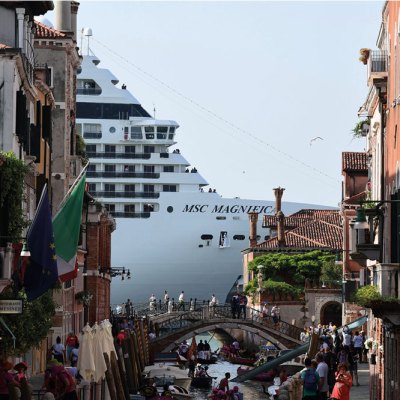Beneath the celestial vistas of Parma Cathedral’s frescoed dome, two men swing like trapeze artists from ropes crisscrossing under the roof as though in a circus tent. They seem to be attempting to join the swirling vortex of angelic limbs in Correggio’s scene of the Virgin’s Assumption above them. But they are actually members of EdiliziAcrobatica, an Italian construction company specialising in rope access building interventions. On this occasion, the company has been drafted in to repair a bell in the cathedral.
EdiliziAcrobatica’s team has rock-climbed up and abseiled down some of Italy’s most significant historic monuments. The company has worked on the Ponte Vecchio in Florence, Siena Cathedral, and the Roman Forum, to name a few. It has also intervened in banks, apartment blocks and various other public and private buildings. Suspended from ropes, the acrobatic technicians can perform a whole range of tasks, from the waterproofing of roofing to welding – all the necessary tools in bags and buckets attached to their harnesses. To watch the team at work is a breathtaking and nail-biting experience. From street level, they are minute figures poised on the roof of Parma’s dome to replace copper panels damaged by rain or casually dangling above the waters of the Arno to repair a leaking fountain on the Ponte Vecchio.
At the Duomo in Siena. Courtesy EdiliziAcrobatica

It may seem like a daredevil stunt, calling to mind the famous photo of workers perilously eating lunch on a crossbeam of the Rockefeller Center (which it later emerged was staged as publicity for the new skyscraper). Crowds of tourists do often gather to watch, but the building company didn’t choose to specialise in these acrobatic techniques just for the spectacle. Rope access, a construction work-at-height technique that started to become popular in the 1980s, comes with a multitude of advantages over traditional scaffolding, as Riccardo Iovino – who founded EdiliziAcrobatica in 1994 – explains via email.
At the forefront is safety. Workers are attached by two ropes, one for safety, and ropes can also relay equipment. Although founder Iovino was, as a skipper, at home shimmying up and down rigging – and was thus inspired to adopt the technique professionally – EdiliziAcrobatica’s workers are not expected to have a mountaineering or caving background. The company assists the construction workers – who are overseen by specialist surveyors – with training and obtaining the required permit for rope access work. Thus, suspended from the side of a building, EdiliziAcrobatica’s technicians can carry out restoration work, paint walls, clean windows, replace gutters and repair unsafe elements of a building in total safety.
That’s not to say that these strict safety procedures dampen the thrill of the work. Enzo Spitale, who began as an acrobatic builder and now acts as coordinator overseeing the team in Italy, returned from his interview 10 years ago thinking it was all completely mad. But he now says his employment at EdiliziAcrobatica was a life-changing opportunity. Dangling from a Renaissance dome or a medieval bridge, ‘you feel one step away from the sky,’ Spitale says. ‘It is unique and unimaginable for those with their feet on the ground.’
Acrobats on the roof of Duomo di Parma, 2021. Courtesy EdiliziAcrobatica

This aspect of the job comes with its own risks. ‘It is always important, as I remind the new company recruits, never to lose concentration at work,’ says Spitale. ‘We are suspended from ropes several metres off the ground, we have to pay attention to what we are doing and not get distracted by the clouds!’
For the buildings and monuments, meanwhile, there are a number of advantages. Rope access work means no unsightly, encumbering and costly scaffolding to be erected. As well as lowering the budget for interventions, this provides what Iovino calls ‘a series of priceless intangible advantages: no view blocked, total freedom, light and cleanliness during works’. For historic monuments like churches or bridges which are open to the public, this also means potentially avoiding an inconvenient period of closure. Unlike scaffolding, which has to be roped off during installation and dismantling, rope access interventions can be undertaken with minimal or no areas closed off to the public.
The built fabric is also protected from potential damages caused by scaffolding structures. Scaffolding has been a traditional method for work-at-height (that is, work done in a place where falling carries a risk of injury) at least since the Greeks. The Berlin Foundry Cup, a red-figure Attic drinking cup dating from the 5th century BC, depicts a bronze statue of a warrior supported by scaffolding. Evidence of this construction method can be seen on the walls of many ancient Roman buildings, which are peppered with rectangular putlog holes – recesses created to support the scaffolding beams. However, despite not compromising the structural integrity of the walls, putlog scaffolds (which are still used for the construction of new buildings, where the holes can be filled in) and independent tied scaffolding, which is normally fastened to a building for security, can damage fragile historic buildings.
At the Roman Forum. Courtesy EdiliziAcrobatica

The speed of setting up and dismantling rope access equipment also means interventions are much more flexible. If bad weather is forecast, work can be rescheduled with relative ease. It means inaccessible areas of a building can be more easily reached and repairs on several different elements can be scheduled together. Urgent repair work can also be carried out in a timely manner. It’s not surprising that rope access is fast becoming one of the most popular work-at-height methods. EdiliziAcrobatica, one of a growing number of rope access companies in Europe, now employs 1,200 workers and has branches in France and Spain.
The popularity of acrobatic builders is not just limited to the construction world either. This year, the company’s human resources administrator Anna Marras founded Super Eroi Acrobatici, a non-profit organisation that arranges for workers dressed up as superheroes to abseil down some of Italy’s principal hospitals. Children in the paediatric department of the Gesù Bambino Hospital in Rome gaze amazed as Spiderman sails past the window, using the same equipment he may well have employed the day before to clear the gutters of an ancient Roman temple.


